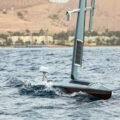The Defense Advanced Research Projects Agency, DARPA, is turning its gaze moonward and laying the foundation for lunar infrastructure development and a booming off-world economy that may become the hub of humanity’s next chapter.
At the heart of this venture, DARPA recently announced the launch of the Lunar Guidelines for Infrastructure Consortium, or LOGIC, which aims to draw the future of interconnected off-world societies one step closer.
“Widespread exploration and commerce on and around the Moon are on the horizon,” Dr. Michael “Orbit” Nayak, program manager in DARPA’s Strategic Technology Office, said. “With LunA-10, we’re studying the technologies that can help to get us there – and interoperability needs to be part of the picture from the start.”
For eons, the Moon has captured humanity’s imagination. Now, as technological advancements beckon a new era of exploration and habitation, the challenge of lunar infrastructure development becomes paramount.
DARPA aims to tackle this monumental task by orchestrating a broad-spectrum collaboration encompassing government agencies, the commercial sector, academia, and international stakeholders to create a robust lunar economy and a cohesive lunar community.
But why is there a pressing need for an integrated approach to Lunar Infrastructure Development?
The answer is simple yet multifaceted. A thriving lunar economy, once the realm of science fiction, is now on the precipice of becoming a reality. Shareable, scalable commercial systems will be at the core of this lunar economy.
However, a crucial question arises: How will these varied systems harmoniously coexist and interact?
DARPA’s LOGIC initiative looks to answer this challenge by untangling the complexities of lunar infrastructure and identifying and recommending standards for interoperability. The process is not just about creating individual pieces of technology but also ensuring these technologies communicate and work seamlessly together, forming a cohesive whole.
Johns Hopkins University Applied Physics Laboratory will provide technical stewardship and management for LOGIC’s vision: to establish a self-reliant, independent forum where experts from across the globe can unite, brainstorm, and collaborate for the greater good of the entire lunar community.
Currently, DARPA is only focusing on building a robust lunar economy. However, the work done in LOGIC will also lay the foundation for interoperable commercial ecosystems that can be applied toward establishing off-world societies beyond the Moon.
“While other efforts focus on technology development, LOGIC will zero in on how systems work together,” Dr. Nayak explained. “We’re looking for maximum participation from the public and private sectors and from international stakeholders.”
Ultimately, LOGIC is the latest testament to DARPA’s renewed commitment towards expanding humanity into a multi-planetary species with burgeoning off-world societies.
In August, DARPA announced the launch of a 10-year Lunar Architecture capability study, dubbed “LunA-10.” According to DARPA, the aim of LunA-10 is to rapidly develop technology concepts that move away from individual scientific efforts toward a series of shareable, scalable systems that interoperate and create monetizable services for future lunar users.
“A large paradigm shift is coming in the next 10 years for the lunar economy,” said Dr. Nayak. “To get to a turning point faster, LunA-10 uniquely aims to identify solutions that can enable multi-mission lunar systems – imagine a wireless power station that can also provide comms and navigation in its beam.”
DARPA is renowned for pushing the boundaries of what’s possible in defense technology. However, agency documents make it clear that the programs are grounded in the 1967 Outer Space Treaty and that all developments from LOGIC and LunA-10 will be for scientific and peaceful purposes.
That said, NASA Administrator Bill Nelson has previously warned that if the U.S. and its Allies didn’t establish a permanent presence first, China could attempt to claim regions of the Moon as its own sovereign territory.
“It is a fact: we’re in a space race,” Nelson told Politico. “And it is true that we better watch out that they don’t get to a place on the Moon under the guise of scientific research. And it is not beyond the realm of possibility that they say, ‘Keep out, we’re here, this is our territory.'”
Complementing these ambitious plans, DARPA says LOGIC will work closely with NASA’s Lunar Surface Innovation Initiative (LSII) and Lunar Surface Innovation Consortium (LSIC). These joint efforts will be directed towards setting up international technical standards in critical areas.
From power distribution and communication systems to navigating the intricacies of cislunar air and space traffic control, collectively, NASA and DARPA intend to cover a broad spectrum of Lunar Infrastructure Development challenges.
Ultimately, DARPA’s recent launch of LOGIC and LunA-10 signal a shift from mere celestial curiosity to strategic, sustainable off-world habitation. Achieving this will only allow humanity to drive deeper into the cosmos.
In an interview with Vice News, software engineer and “global resilience guru” Vinay Gupta underscored the importance of humanity moving forward towards sustainable off-world development.
“Making life interplanetary, and then interstellar, enables creation to generate untold wonders over potentially trillions of years,” said Gupta. “We have no idea how long human life could last. If we can get it off this one fragile, risk-filled, tiny sphere into the ocean of darkness and light above our heads and into every nook and cranny of the observable sphere.”
“We owe all the potential futures that could emerge from our present the possibility of existence, and to accomplish this, we must go not only into space, but eventually, by any means found necessary, into the stars.”
Tim McMillan is a retired law enforcement executive, investigative reporter and co-founder of The Debrief. His writing covers defense, national security, and the Intelligence Community. You can follow Tim on Twitter: @LtTimMcMillan. Tim can be reached by email: tim@thedebrief.org or through encrypted email: LtTimMcMillan@protonmail.com

